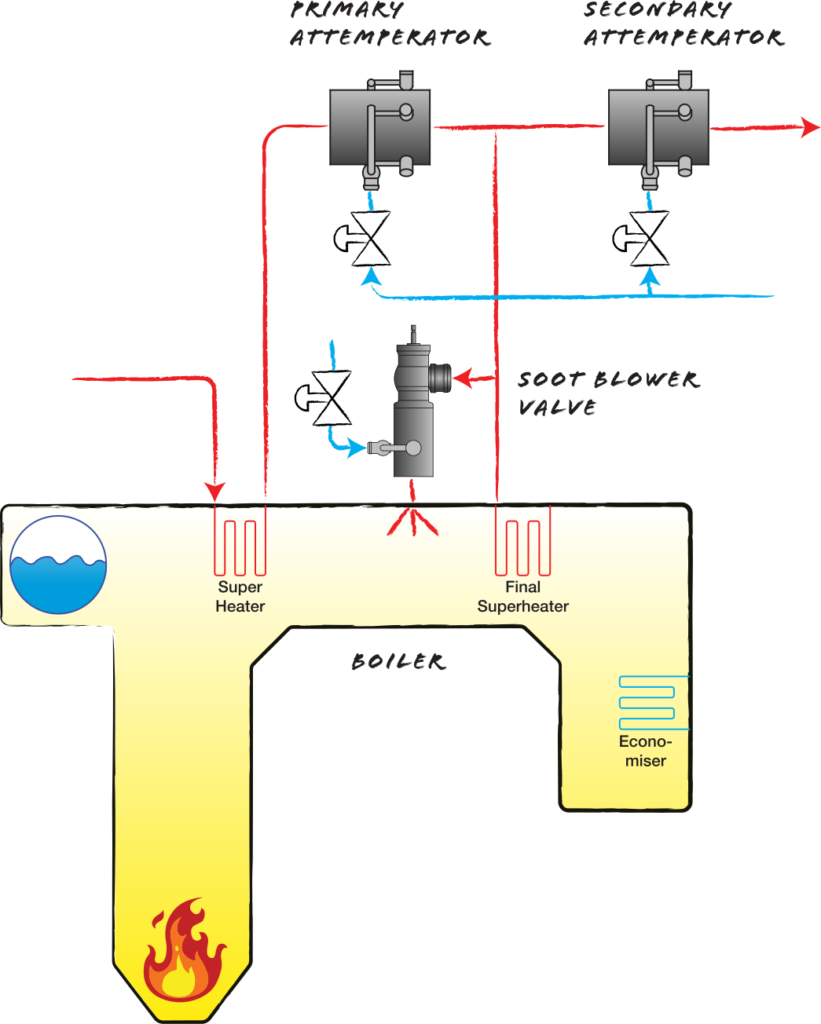Soot Blowing in Boiler : Soot blowing in a boiler is a maintenance process designed to remove soot and ash deposits that accumulate on the heat transfer surfaces of the boiler, such as tubes and economizers. These deposits can significantly hinder the efficiency of the boiler by acting as insulators, reducing heat transfer, and potentially leading to overheating or even fires if left unchecked.

What is soot blowing in Boiler?
A soot blowing is a procedure of removing the soot built up on the surface of pipe when hot exhaust gas pass through it. or, we can simply define it as – the process of removal of soot deposits exhaust gas passing tubes with the help of steam or air. It is done by a device name called soot blower.
Suggested Read : Boiler gauge Glass Blow Through procedure
What is the purpose of soot blowing ?
Soot blowing is an essential maintenance procedure used in boilers, especially on ships. Its primary purpose is to remove soot and ash deposits that accumulate on heat transfer surfaces, ensuring optimal thermal efficiency and safe operation. Here are the key points regarding soot blowing:
Purpose of Soot Blowing
- Maintain Heat Transfer Efficiency: Soot deposits act as insulators, reducing the effective surface area available for heat transfer. Regular soot blowing helps maintain efficient heat transfer, ensuring that water converts to steam effectively.
- Prevent Overheating and Fires: Thick soot layers can lead to overheating of boiler tubes and, in severe cases, can cause fires, especially if the soot becomes wet and lowers its flash point.
- Enhance Boiler Efficiency: Regular removal of soot increases boiler efficiency, allowing the system to operate at its designed capacity and reduce fuel consumption.
- Reduce Emissions: A cleaner heat exchange surface can lead to more complete combustion of fuel, resulting in lower emissions of pollutants.
- Extend Equipment Lifespan: By preventing excessive soot build-up, soot blowing reduces the risk of corrosion and other damage, extending the life of the boiler and associated components.
Note :
- On Ships: Soot blowing is typically performed using steam in the middle of the ship, where Economizer Gas Bypass (EGB) systems are prevalent. This method effectively dislodges soot from boiler tubes.
- In Port: When the main engine is not in operation, air is often used for soot blowing in boilers. This method, while effective, may be less efficient than steam.
- Modern Techniques: Some modern ships utilize chemicals combined with air to enhance soot removal, making the process more efficient and potentially reducing the frequency of mechanical soot blowing.
Regular soot blowing is crucial for the safe and efficient operation of marine boilers and heat exchangers. By removing soot deposits, it helps ensure that the systems function effectively, reducing risks of fire and improving overall operational efficiency.
Soot Blowing Procedure for Economizer through Steam
1.Notify the Bridge: Inform the bridge before starting the soot blowing operation to ensure that all personnel are aware and can monitor the situation.
2.Check Wind Direction: Assess the wind direction to avoid blowing soot towards areas where personnel or equipment may be affected.
3.Verify Boiler Parameters:
- Steam Pressure: Check the current steam pressure of the boiler.
- EGB Temperature: Measure the temperature of the Exhaust Gas Boiler (EGB).
4.Adjust Boiler Pressure:
- If the boiler pressure is below the required level (ideally around 10 bar), increase the pressure:
- Increase Firing: Raise the fuel input to boost steam production.
- Close Steam Lines: Close the steam lines from tanks (e.g., waste oil tanks) to redirect steam for soot blowing.
5.Initiate Soot Blowing:
- Once the boiler pressure reaches approximately 10 bar, begin the soot blowing operation.
- Continue the process until the boiler pressure drops to between 6-7 bar.
6.Post-Soot Blowing Monitoring:
- After completing the soot blowing, monitor the following:
- Steam Pressure Recovery: Ensure that the steam pressure of the boiler gradually increases, indicating improved efficiency.
- EGB Temperature: Watch for a decrease in the EGB temperature, which suggests effective soot removal.
Important Notes
- Pressure Drop Warning: A significant drop in steam pressure may indicate that the feed pump is losing suction from the cascade tank.
- Temperature Increase Warning: An increase in EGB temperature could signify potential EGB fire, requiring immediate investigation and action.
By following these steps carefully, the soot blowing process can enhance boiler efficiency and safety while minimizing operational risks.
Soot Blowing in Boiler through Air
1.Notify the Bridge: Inform the bridge before starting the operation to ensure safety and awareness.
2.Check Wind Direction: Assess wind direction to avoid blowing soot towards personnel or sensitive equipment, as this poses a fire hazard.
3.Raise Boiler Pressure: if necessary, raise the boiler pressure using previously mentioned methods (e.g., increasing fuel firing or adjusting steam lines).
4.Open the Drain Valve: Open the drain valve on the soot blow pipe and ensure that the drain runs clear of any residual water or condensate.
5.Open the Soot Blower Valve: Open the soot blower valve to initiate air flow.
6. Increase Air Supply: Increase the air supply to the boiler by 50% to enhance the effectiveness of soot blowing.
7. Operate the Steam Valve: Open the steam valve by turning the wheel. Maintain this position for 20-30 seconds to allow for effective soot removal.
8. Close the Valves: After the designated time, close the steam valve and then close the main soot blower valve.
9. Final Drain Check: Open the drain valve once more and then close it to ensure that any residual soot or condensate is expelled.
Important Notes
- Wind Direction: Always check wind direction prior to commencing soot blowing to minimize fire hazards.
- Duration: Do not engage in soot blowing for extended periods to avoid potential operational issues or equipment damage.
- Monitor Conditions: Keep an eye on system parameters during the operation to ensure safe and efficient soot removal.
By adhering to this procedure, you can effectively manage soot accumulation using air while prioritizing safety and operational integrity.
